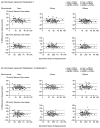Exploring intra- and inter-reader variability in uni-dimensional, bi-dimensional, and volumetric measurements of solid tumors on CT scans reconstructed at different slice intervals
- PMID: 23489982
- PMCID: PMC3823057
- DOI: 10.1016/j.ejrad.2013.02.018
Exploring intra- and inter-reader variability in uni-dimensional, bi-dimensional, and volumetric measurements of solid tumors on CT scans reconstructed at different slice intervals
Abstract
Objective: Understanding magnitudes of variability when measuring tumor size may be valuable in improving detection of tumor change and thus evaluating tumor response to therapy in clinical trials and care. Our study explored intra- and inter-reader variability of tumor uni-dimensional (1D), bi-dimensional (2D), and volumetric (VOL) measurements using manual and computer-aided methods (CAM) on CT scans reconstructed at different slice intervals.
Materials and methods: Raw CT data from 30 patients enrolled in oncology clinical trials was reconstructed at 5, 2.5, and 1.25 mm slice intervals. 118 lesions in the lungs, liver, and lymph nodes were analyzed. For each lesion, two independent radiologists manually and, separately, using computer software, measured the maximum diameter (1D), maximum perpendicular diameter, and volume (CAM only). One of them blindly repeated the measurements. Intra- and inter-reader variability for the manual method and CAM were analyzed using linear mixed-effects models and Bland-Altman method.
Results: For the three slice intervals, the maximum coefficients of variation for manual intra-/inter-reader variability were 6.9%/9.0% (1D) and 12.3%/18.0% (2D), and for CAM were 5.4%/9.3% (1D), 11.3%/18.8% (2D) and 9.3%/18.0% (VOL). Maximal 95% reference ranges for the percentage difference in intra-reader measurements for manual 1D and 2D, and CAM VOL were (-15.5%, 25.8%), (-27.1%, 51.6%), and (-22.3%, 33.6%), respectively.
Conclusions: Variability in measuring the diameter and volume of solid tumors, manually and by CAM, is affected by CT slice interval. The 2.5mm slice interval provides the least measurement variability. Among the three techniques, 2D has the greatest measurement variability compared to 1D and 3D.
Copyright © 2013 Elsevier Ireland Ltd. All rights reserved.
Conflict of interest statement
No conflict of interest has been declared.
Figures



References
-
- WHO handbook for reporting results of cancer treatment. Geneva (Switzerland): World Health Organization; 1979. Offset Publication No. 48.
-
- Miller AB, Hoogstraten B, Staquet M, et al. Reporting results of cancer treatment. Cancer. 1981;47(1):207–14. - PubMed
-
- Therasse P, Arbuck SG, Eisenhauer EA, et al. New guidelines to evaluate response to treatment in solid tumors. European Organization for Research and Treatment of Cancer, National Cancer Institute of the United States, National Cancer Institute of Canada Journal of the National Cancer Institute. 2000;92(3):205–16. - PubMed
-
- Eisenhauer EA, Therasse P, Bogaerts J, et al. New response evaluation criteria in solid tumours: revised RECIST guideline (version 1. 1) European Journal of Cancer. 2009;45(2):228–47. - PubMed
-
- Moertel CG, Hanley JA. The effect of measuring error on the results of therapeutic trials in advanced cancer. Cancer. 1976;38(1):388–94. - PubMed
Publication types
MeSH terms
Grants and funding
LinkOut - more resources
Full Text Sources
Other Literature Sources

